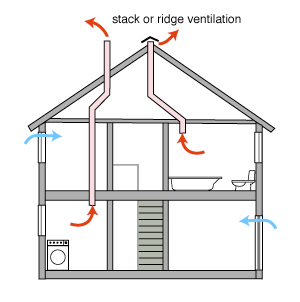Our Products

- Home
- Ventilation Systems
- Ventilation Services
-
Products
- HRV Units & Controllers
- Radial / Manifold Duct Systems
- Filters & Service Calls
- Insulated Ducting
- Low Energy Constant Volume Extract Fans
- Extra ventilation / Insulation Products and General Accessories
- Single Room Heat Recovery Units
- Renson Demand Control Systems
- Covid Solutions
- Airtight Tapes & Membranes
- Contacts
Build airtight... Ventilate right
Air infiltration through the fabric of the building (cracks, gaps in door/window frames, etc.) participate to the indoor air renewal by letting fresh air in or exhaust air out depending on how air pressure is applied outside the fabric (by the wind) and inside (by fans, air density, etc.). However, air infiltration is totally uncontrolled, can lead to excessive heat losses and condensation within the fabric of the building, as well as creating discomfort due to draughts.
With constant improvements in energy standards in homes, airtightness has become a key requirement to achieve a good level of energy efficiency. This is achieved by using membranes, tapes, gaskets and sealants to create a layer impermeable to air wrapping the whole house. Openings such as windows and doors must be also be installed in an airtight manner at the junction with the building fabric (wall, roof) and close tightly. The airtightness of existing homes can also be improved by applying some of the above measures where possible. Part L of the Building Regulations sets out the minimum level of airtightness in new Irish houses (7 m3/h,m2 when blower door tested at 50 Pa).
However, in our rush to make homes more airtight, we should also be very conscious that providing purposeful ventilation becomes essential to maintain good IAQ.

Source: Part F TGD.
A key advantage of whole-house mechanical extract ventilation is that since ventilation is continuous, the equivalent area of background ventilators (air inlets) required by the Building Regulations (TGD Part F, UK) are much lower (up to 3 times) for continuous extract systems than with the natural ventilation approach with intermittent extracts. With less and smaller wall vents or trickle vents required, the risk of excessive air infiltration on cold, windy days is considerably reduced, so are discomfort and heat losses.
Information
Customer Service
Contact Us
A+ Ventilation Supplies / Ecoaer
Unit 4 Crossagalla Ind Est
Ballysimon Road
Limerick
V94 P273
Tel.: +353 (0)61 533996
Email: info@ecoaer.com
© A+ Ventilation Supplies 2025




